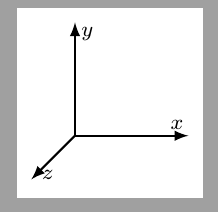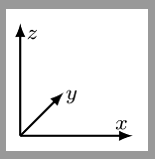|
Per Default sehen die Koordinatenachsen so aus: Kann mir mal jmd. sagen, wie ich folgendes korrekt mache: 1/2. y-Achse und z.Achse vertauschen. \documentclass[margin=5pt, tikz]{standalone} \usepackage{tikz} \usetikzlibrary{calc} \begin{document} \begin{tikzpicture}[scale=1.5, %z ={(0,0,-cos(45))}, % z ={(0,0,-1)}, >=latex, font=\footnotesize, ] % CoSy \begin{scope}[-latex, thick] \foreach \P/\s/\Pos in {(1,0,0)/x/above, (0,1,0)/y/right, (0,0,1)/z/right} \draw[] (0,0,0) -- \P node[\Pos, pos=0.9,inner sep=2pt]{$\s$}; \end{scope} \end{tikzpicture} \end{document} |
|
Du kannst beispielsweise y={(0,0,-1)}, z={(0,1cm)}, verwenden. Dann muss die Anpassung von \documentclass[margin=5pt, tikz]{standalone} \usepackage{tikz} \usetikzlibrary{calc} \begin{document} \begin{tikzpicture}[ scale=1.5, y={(0,0,-1)},% vor der Anpassung von z z={(0,1cm)}, >=latex, font=\footnotesize, ] % CoSy \begin{scope}[-latex, thick] \foreach \P/\s/\Pos in {(1,0,0)/x/above, (0,1,0)/y/right, (0,0,1)/z/right} \draw[] (0,0,0) -- \P node[\Pos, pos=0.9,inner sep=2pt]{$\s$}; \end{scope} \end{tikzpicture} \end{document} Oder Du nimmst y={(3.85mm,3.85mm)}, z={(0,1cm)}, Dann ist die Reihenfolge von
Aber Du kannst auch einen anderen Wert verwenden, wenn Du das möchtest: y={({cos(45)*1cm},{sin(45)*1cm})}, z={(0,1cm)}, |


